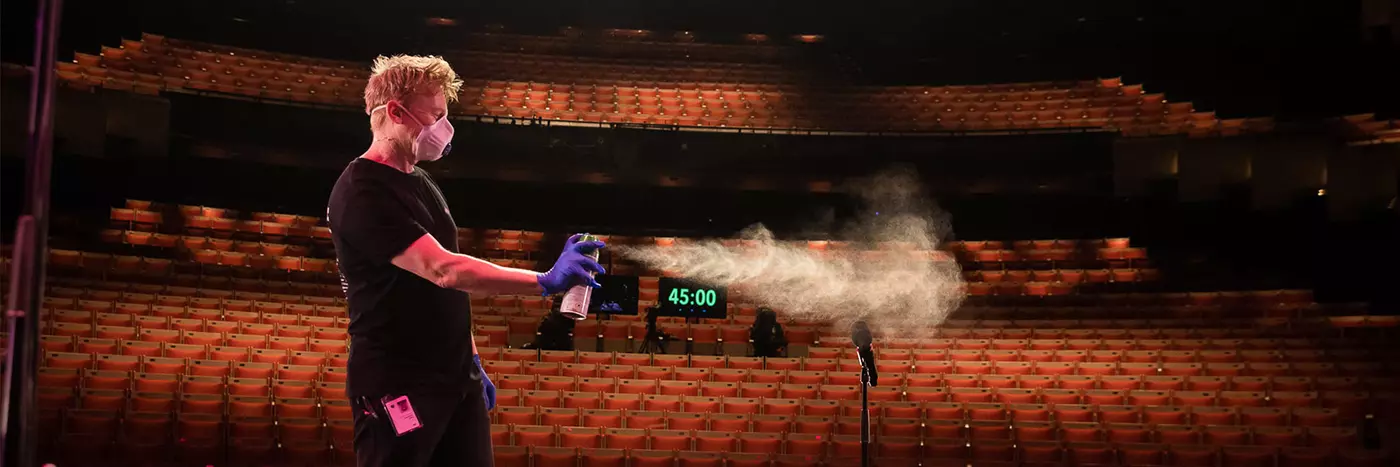Playing to an empty House
The halls might be closed, but a newly built virtual stage is broadcasting shows from inside the Sydney Opera House
Last week the sea of empty red seats eagerly facing the Joan Sutherland Theatre stage was empty. After weeks of working alone, silence has become the norm for most people. But the stillness of an empty theatre with no crew, no musicians, and no performers, is a quiet like no other.
Until now, the stage of the Joan Sutherland, nestled inside the second largest sail of the Sydney Opera House, has been kept aglow by a single ghost light. As art institutions around the world have been streaming performances, readings, comedy, dance and music to people at home, the creativity of the arts community has driven the team at Sydney Opera House to explore new forms of content that connect with audiences in real time, and to bring artists back onto the stage.
As a lithe crew began to pull tape measures between props on stage to ensure performances complied with social distancing regulations, a group of tap aficionados known as The Tap Pack discussed how they would fit what would normally be weeks of rehearsals into three days. The crew talked about the late arrivals of new tap shoes because of a backlog at the post office and sanitising their canes throughout the show. One joked about using hand sanitiser during the performance: “Yeah, sure. Throw it away once you’re done...just don’t hit the camera.”
Stuart Buchanan, who heads up the Opera House’s Digital Programming, is optimistic that the new stage will bring performances to life.
“The arts community have shown creativity and resilience during COVID-19. It encouraged us to find our own ways to connect in real time, and to provide support for artists and crew in this difficult moment.
“There’s nothing quite like the thrill of a live performance where everyone gets to share the experience; the Digital Stage means we can stream new shows every week and do just that.”
Inside the now-empty halls of the Opera House, the production team are rethinking how they work. Aubs Tredget, a Production Manager at the House, is part of the process it takes to deliver an artist’s vision to the stage. He explains that like any show, digital or otherwise, there are clever people contributing to the complex creative process.
“It’s dictated by the shape of the building. It’s defined by the height of the proscenium and the width and depth of the stage. In film and television, you usually have a bit more space and freedom to move cameras around even through the stage space; they're effectively large warehouses with no predetermined audience point of view.”
The space then needs to be lit. “As our cameras act as the audience’s eyes, effectively replacing the audience,” says Aubs, “the first thing our team does is determine what the camera will see.”
The Opera House’s Lighting team choose the appropriate fixtures, mindful that the stage needs to be versatile. The programming of the Digital Stage is incredibly diverse in nature – often the stage will be host to a serious talk and is then revamped for a high-energy music act within the space of an hour. The lighting rig has to provide different looks to choose from.
Audio is very important as artists deserve to be heard at their best. Like the Lighting team, the Sound team choose a range of microphones and mixing equipment that will capture the best voices and instruments playing, but gear that can also be quickly deployed or adapted to the needs of each act.
Cameras, lights and sound equipment capture the performance and send everything they see and hear back to the Recording and Broadcast Studio. A good signal transports system is essential. To ensure that quality is not lost the Technology team have set up optical fibre cable that runs between the stage in the Joan Sutherland Theatre and the Recording and Broadcast Studio.
Like with sound, Aubs is conscious of not sacrificing the experience. A sense of intimacy is difficult to achieve, while also giving the artist space to perform.
“Our Recording and Broadcast team makes it as intimate an experience as possible, but without intruding into the artist’s space,” he says.
On stage The Tap Pack are reconfiguring intricate choreography which would normally include weaving in and out of each other, dodging, sliding and tapping at the same time.
“We have had to plot through all the dance numbers and make sure that we can do it safely in regards to the social distancing rules. It has been a delicate process to make sure it works seamlessly however we will just make sure we find each other through sightlines as opposed to physically.
“A large proportion of our choreography happens all together on stairs so we’ve had to reconfigure their placement and move around the stage a little bit more.”
Many aspects of this rehearsal are business as usual for The Tap Pack; they’re bent on having fun no matter the circumstances. In terms of how the performance will translate for audiences, the boys are certain it’ll translate. It all comes down to the energy.
“Without an audience sitting in front of us, we’ll need to make sure we’re having double the fun so it can be felt in people’s homes,” they say. “Luckily, the show is built in a way that we’re already having a blast and so everywhere we go we’re inviting people to have fun with us.
“We’ve performed the show with and without a live band or to an intimate group of people but, no matter where we stage it, there is always a huge sense of camaraderie and joy.”
